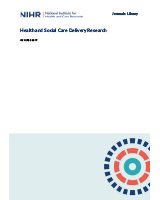This work was produced by Maben et al. under the terms of a commissioning contract issued by the Secretary of State for Health and Social Care. This is an Open Access publication distributed under the terms of the Creative Commons Attribution CC BY 4.0 licence, which permits unrestricted use, distribution, reproduction and adaptation in any medium and for any purpose provided that it is properly attributed. See: https://creativecommons.org/licenses/by/4.0/. For attribution the title, original author(s), the publication source – NIHR Journals Library, and the DOI of the publication must be cited.
NCBI Bookshelf. A service of the National Library of Medicine, National Institutes of Health.
Maben J, Taylor C, Jagosh J, et al. Causes and solutions to workplace psychological ill-health for nurses, midwives and paramedics: the Care Under Pressure 2 realist review. Southampton (UK): National Institute for Health and Care Research; 2024 Apr. (Health and Social Care Delivery Research, No. 12.09.)

Causes and solutions to workplace psychological ill-health for nurses, midwives and paramedics: the Care Under Pressure 2 realist review.
Show detailsTABLE 29
Mapping interventions to causes
| Risk factors for work-related stress (HSE Management Standards*) | Specific ‘cause’ | Interventions: formal | Interventions: informal |
|---|---|---|---|
| N/M/P causes | |||
| Demands (workload, work patterns, work environment) | Staff shortages and high attrition | Primary
| Primary
|
| Pressure of work in service in which demand continues to increase/unmanageable workload | Primary
| Primary
| |
| Working long shifts with no/few breaks | Secondary
| Primary
| |
Secondary
| |||
| Inadequate work-life balance | Primary
|
| |
| Serve and sacrifice | Multifocal
|
| |
| Exposure to repeated episodes of trauma | Secondary
|
| |
|
| ||
Secondary
| |||
| Experiencing death |
|
| |
| Prolonged/cumulative stress |
|
| |
| Emotional labour | |||
| Profession-specific causes (potentially) | |||
| Working on-call | |||
| Lack of continuity of care | |||
| Unnecessary call-outs | |||
| Heavy cognitive load/rapid decisions | Secondary: stress-management | Secondary: stress-management | |
| High risk of sustaining injury | |||
| Being a profession under scrutiny | |||
| Control (how much say in the way you work) | Lack of control/autonomy | Primary:
| |
| Support (encouragement, sponsorship and resources provided by org, line managers and colleagues) | Not feeling supported/valued |
|
|
| Stigma |
|
| |
| Not having space/time to debrief after trauma or having inappropriate support |
|
| |
| Not having basic ‘hygiene’ needs met |
|
| |
| Profession-specific causes (potentially) | |||
| Lone working |
| ||
| Relationships (promoting positive working to avoid conflict; dealing with unacceptable behaviour) | Poor relationships with colleagues/incivility/bullying | Primary
| Primary
|
| Challenging relationships with patients, public, clients | Secondary
| ||
| Not feeling able to speak out |
| ||
| Profession-specific causes (potentially) | |||
| Fear of assault/abuse from public/patients | |||
| Role (clarity, not conflicting) | Transition shock/Reality shock (newly qualified) |
| |
| Values incongruence/theory-practice gap; moral distress | |||
| Unclear role boundaries/clarity |
| ||
| Role intensity |
| ||
| Change (organisational change management and communication) | Not being involved in change | ||
| Other risk factors | |||
| WHO? | Ageing population | Tackling retirement barriers | |
| Gender | |||
| Ethnicity | Zero tolerance; implicit bias training; EDI projects | ||
| Sexual orientation/gender identity | Zero tolerance; implicit bias training; Rainbow Badge and EDI projects. | ||
| Disability | Zero tolerance; implicit bias training | ||
| WORK CONDITIONS | Pay | Remove pay caps/restraints; ensure student bursary remains | |
| Promotion opportunities | |||
| ROLE/TYPE OF JOB | Newly qualified | Preceptorship programmes | |
| Leaders |
| ||
| Working in orphan specialties | |||
| Working with high-risk patient groups | |||
| WHEN | After trauma exposure | As per above exposure to trauma/death/cumulative stress POPPY | As per above exposure to trauma/death/cumulative stress |
| When under investigation/during complaints |
KEY: Red, No/few interventions/much evidence needed; yellow, some interventions/more evidence needed; green, some interventions/good evidence.
- Mapping interventions to causes - Causes and solutions to workplace psychologica...Mapping interventions to causes - Causes and solutions to workplace psychological ill-health for nurses, midwives and paramedics: the Care Under Pressure 2 realist review
Your browsing activity is empty.
Activity recording is turned off.
See more...